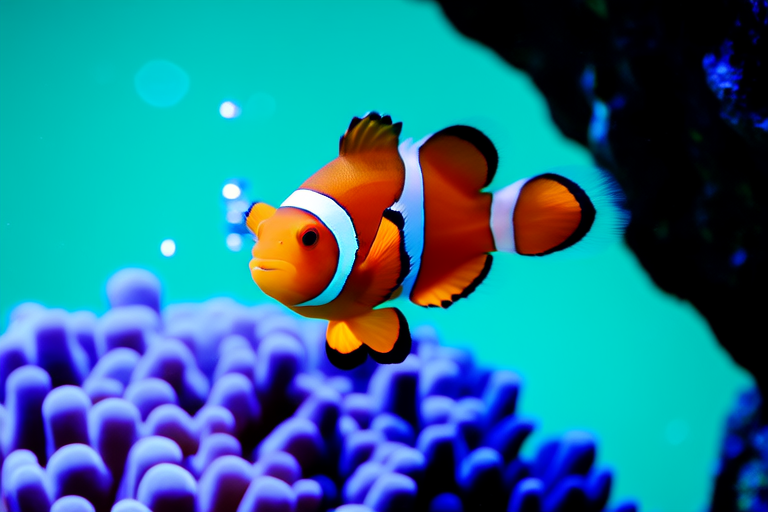How to Care for Your Clownfish Like a Pro
Welcome to your comprehensive guide on caring for clownfish! Whether you’re a seasoned aquarist or just starting out, this article will provide you with all the essential information needed to ensure your clownfish thrive in their new home. We’ll cover everything from setting up the perfect tank to maintaining optimal water conditions, feeding them properly, and even tips for breeding. Let’s dive right in!
Suitable Tank Conditions
The first step in providing a healthy environment for your clownfish is creating a suitable tank setup. Clownfish are native to the warm waters of the Indo-Pacific region, so it’s important to replicate these conditions as closely as possible. Start by selecting a tank that is at least 30 gallons in size; larger tanks allow more space for swimming and reduce stress on the fish.
Clownfish need plenty of hiding spots, such as live rock or artificial structures like caves and crevices. These not only provide shelter but also mimic their natural reef environments. Make sure there’s enough room for each clownfish to have its own territory without overcrowding.
Proper filtration is crucial to maintaining clean water. Choose a filter that can handle at least four times the volume of your tank per hour. This ensures that waste products are removed efficiently while keeping nitrate levels low.
Water Parameters
Maintaining stable water parameters is key to keeping your clownfish healthy. Here’s what you should aim for:
- Temperature: Keep the temperature between 76°F and 82°F (24°C – 28°C). Use a heater if necessary.
- pH: Maintain a pH level around 8.1 to 8.4. Regular testing with a reliable pH kit will help you stay within this range.
- Salinity: Aim for specific gravity between 1.020 and 1.025. A hydrometer can measure salinity accurately.
- Nitrogen compounds: Ammonia and nitrite should always be undetectable, while nitrate should remain below 20 ppm.
Regular water changes—about 10% weekly—are recommended to keep these levels stable. Always acclimate new fish slowly when introducing them to your tank to avoid shocking their systems.
Diet Requirements
Clownfish are omnivorous, meaning they eat both plant matter and small animals. In captivity, they can thrive on a varied diet consisting of high-quality flake foods, pellets, frozen brine shrimp, and mysis shrimp. Offer small portions multiple times throughout the day rather than one large feeding session.
It’s important to supplement their diet with algae wafers or spirulina flakes to ensure they get all necessary nutrients. Avoid overfeeding, as excess food can lead to poor water quality and obesity in your clownfish.
Some hobbyists report success with occasional feedings of fresh vegetables like zucchini or spinach, but these should be offered sparingly due to potential digestive issues.
Compatible Tank Mates
Selecting appropriate tank mates for your clownfish is vital to ensuring harmony within your aquarium community. Clownfish generally coexist well with other peaceful species, especially those found naturally alongside them in coral reefs. Suitable companions include:
- Other small, non-aggressive fish like cardinal tetras or dwarf gouramis.
- Hermit crabs and other invertebrates that won’t prey upon clownfish eggs or juveniles.
- Other clownfish, provided there is ample space and hiding places available.
Avoid housing clownfish with overly aggressive or territorial species, as this could cause undue stress and fighting. Additionally, refrain from keeping them with predatory fish that might see them as prey.
Common Health Issues
Despite being relatively hardy fish, clownfish aren’t immune to certain health problems. Common ailments include ich (white spot disease), bacterial infections, and parasitic infestations. Early detection and treatment are critical for recovery.
If you notice signs of illness—such as lethargy, loss of appetite, or abnormal physical appearance—it’s best to isolate the affected individual immediately. Consult with a veterinarian specializing in aquatic life for proper diagnosis and medication.
To prevent diseases, maintain excellent water quality through regular maintenance and quarantine any new additions before introducing them to your main tank.
Tips for Breeding
Breeding clownfish can be rewarding but requires careful planning and preparation. First, select a healthy pair of adult clownfish; typically, males will be smaller than females. Once paired, provide them with ample hiding spaces where they can establish a nesting site.
Feed them a nutritious diet rich in protein to encourage spawning. When ready, female clownfish will lay eggs on a flat surface near their chosen hideaway. The male then fertilizes and guards the clutch until hatching occurs.
After approximately ten days, depending on temperature and other factors, tiny fry will emerge from their eggs. At this point, transfer them to a separate rearing tank equipped with appropriate filtration and feeding regime designed specifically for growing larvae.
Patience and dedication are key during breeding cycles, so don’t get discouraged if initial attempts aren’t successful. Each experience brings valuable lessons learned towards future successes.
Conclusion
Caring for clownfish involves creating a stable marine environment and performing regular maintenance tasks. By understanding their dietary needs, choosing compatible tank mates, monitoring water parameters closely, addressing common health issues promptly, and following sound breeding practices, you can ensure long-term happiness and health for your beloved pets.
Remember, every aquarium setup is unique, so adapt these guidelines according to your specific circumstances. With consistent effort and attention, you’ll become adept at caring for clownfish like a pro!
